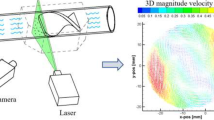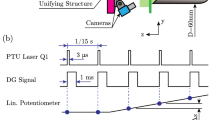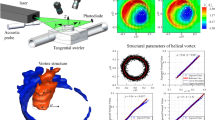Abstract
The stereo PIV, commonly known as the SPIV, is capable of measuring all the three velocity components in a two-dimensional measurement plane and thus classified as 2-D 3-C PIV. Even though the SPIV utilizes a set of two cameras, the positions of the measurement points are assumed to be located in the central plane of the illuminated volume, which is usually the zone of laser light sheet. This assumption makes the SPIV versatile and its calibration procedure very handy. But, if the three-dimensional orientation of the cameras can be calibrated precisely, the three-dimensional position of the particles that may be distributed in the depth of the illuminated zone can be calculated. The authors of this study have proposed a new algorithm that enables the fully three-dimensional measurement by SPIV and it can be classified as 3-D 3-C SPIV. Presently, the three-dimensional turbulent measurement of a plane jet has been carried out with the use of presently proposed 3-D 3-C SPIV and the transverse distributions of the turbulence statistics have been obtained in the depth direction of 3-D 3-C SPIV. The results are compared with those by standard PIV, i.e., 2-D 2-C PIV, and thus, the accuracy and the applicability of 3-D 3-C SPIV have been evaluated.
Graphical abstract











Similar content being viewed by others
References
Adrian RJ (2005) Twenty years of particle image velocimetry. Exp Fluids 39:159–169
Elsinga GE, Scarano F, Wieneke B, van Oudheusden BW (2006) Tomographic particle image velocimetry. Exp Fluids 41:933–947
Hu H et al (2001) Dual-plane stereoscopic particle image velocimetry: system set-up and its application on a lobed jet mixing flow. Exp Fluids 31:277–293
Keane RD, Adrian RJ (1992) Theory of cross-correlation analysis of PIV images. Appl Sci Res 49:191–215
Keane RD, Adrian RJ (1993) Theory of cross-correlation analysis of PIV image, flow visualization and image analysis. Kluwer Academic Publishers, Dordrecht, pp 1–25
Mullin J, Dahm WJA (2002) Highly-resolved three-dimensional velocity measurements via dual-plane stereo particle image velocimetry (DSPIV). AIAA paper 2002-0290
Nishino K, Kasagi N, Hirata M (1989) Three-dimensional particle tracking velocimetry based on automated digital image processing. J Fluid Eng 111:384–391
Prasad AK, Adrian RJ (1993) Stereoscopic particle image velocimetry applied to liquid flow. Exp Fluids 15:49–60
Soloff SM, Adrian RJ, Liu ZC (1997) Distortion compensation for generalized stereoscopic particle image velocimetry. Meas Sci Technol 8:1441–1454
Watanabe A, Ninomiya N, Sugiyama H, Hitomi D (2005) Development of 3-D 3-C PIV considering Scheimpflüg condition. In: Proceeding of 6th international symposium on particle image velocimetry
Acknowledgements
A part of this work has been supported by Mr. Norio Yuzawa, Mr. Shunya Buseki and Mr. Daiki Kono. All supports are greatly acknowledged.
Author information
Authors and Affiliations
Corresponding author
Rights and permissions
About this article
Cite this article
Ninomiya, N., Tanaka, Y., Sotome, S. et al. 3-D measurement of 2-D jet by 3-D 3-C SPIV. J Vis 22, 305–312 (2019). https://doi.org/10.1007/s12650-018-0529-8
Received:
Revised:
Accepted:
Published:
Issue Date:
DOI: https://doi.org/10.1007/s12650-018-0529-8




